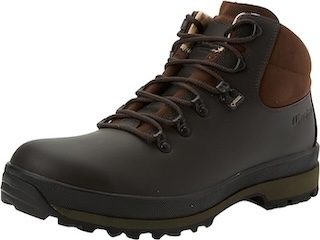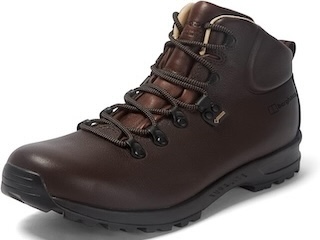Scenic Views and Historic Trails on a Grosmont Walk in the North York Moors
This Grosmont walk starts in the charming village of Grosmont in the North York Moors. Begin at the large car park located just to the west of the village centre, opposite the cricket field. Leave the car park by the main exit, turn left onto the main road, and walk under the railway bridge to enter the village. Follow Front Street through the village, crossing the railway level crossing and continuing straight up the hill.
Soon, you will find a signposted path on your right leading into Doctors Wood. This delightful stretch of woodland is sure to be enjoyable. Continue through the woods until you reach a concrete road. Turn left and follow this road uphill, passing through the farm at Dale End. Continue south past Birch House, and you will soon pass through another farm at Morton Close. The track leads to a minor road where you should turn left and walk up the road for a while.

Turn right onto a track that will guide you south across the moorland to Hawthorn Hill Farm. Skirt around the northern and eastern perimeter of the farm, then descend into a picturesque valley. Here, you will come across a charming ford and stepping stones across Eller Beck, a perfect spot for a peaceful break and perhaps a coffee from your flask.
After crossing Eller Beck, continue your Grosmont walk by heading south up some steep steps. Follow the path that runs parallel with the railway line along Mill Scar, with the railway below to your right. Soon, you will descend to reach Goathland Railway Station. Take a moment to explore this beautiful station if you wish. From the station, continue south-east uphill to join a road, cross it, and take the track south leading to Abbot’s Bridge, which spans Eller Beck.

Cross the bridge and walk west under the railway bridge, passing Abbot’s House and through the caravan park. You will reach a wide track, a disused railway line. Go straight across and keep heading west across the countryside until you reach the Mallyan Spout Hotel in Goathland. Follow the path on the right-hand side of the hotel down a number of steps. At the bottom, turn left and walk a short distance to view the Mallyan Spout (Waterfall). After enjoying the waterfall, retrace your steps and head north, following the signpost for Beck Hole.
The lovely path takes you through wooded areas and beautiful countryside, eventually bringing you to the Rail Trail near Beck Hole. Turn left onto the Rail Trail disused railway line and follow this easy, level path. There are several interesting informational boards along the route, relating to the history of the railway line that once used this path. After about two miles, you will arrive back in Grosmont. Turn left to return to the car park.
This is a delightful nine-mile Grosmont walk in the North York Moors, offering varied scenery, interesting landmarks, and a mix of woodland, moorland, and historical sites.
Grosmont Walk: Maps and Tools
Visit either the OS Maps website or the Outdooractive website to view this walking route in greater detail. Both platforms offer a range of features, including the ability to print the route, download it to your device, and export the route as a GPX file. You can also watch a 3D fly-over and share the route on social media.
Grosmont Walk: Distance, Duration, Statistics
Distance: 8¾ miles
Distance: 14¼ kilometres
Duration: 4¼ hours
Ascent: 1281 feet
Ascent: 390 metres
Type: Circular walk

Recommended Ordnance Survey Map
The best map to use on this walk is the Ordnance Survey map of the North York Moors Eastern Area, reference OS Explorer OL27, scale 1:25,000. It clearly displays footpaths, rights of way, open access land and vegetation on the ground, making it ideal for walking, running and hiking. The map can be purchased from Amazon in either a standard, paper version or a weatherproof, laminated version, as shown below.
About Grosmont
Nestled in the heart of North Yorkshire within the boundaries of the North York Moors National Park, Grosmont is a quaint village steeped in history and charm. Located in Eskdale and part of the Scarborough district, the village has historical variations in its name, including the archaic spelling ‘Growmond’. My Grosmont walk offers visitors the perfect opportunity to explore the village’s scenic beauty and rich heritage.
Historical Background
Early History and Priory
Grosmont’s historical significance began with the establishment of Grosmont Priory in the 13th century. This Grandmontine religious house was one of only three in England and was founded around 1200 when Joan Fossard and her husband gifted approximately 200 acres (80 hectares) of land in the Forest of Egton to the order. The priory, located on the banks of the River Esk, played a vital role in the area’s early religious life. However, a fire in 1360 destroyed much of the priory, and in 1394, the Abbot of Grandmont sold the property to John Hewitt. The priory continued until the dissolution of the monasteries in the 1530s, at which time it had four priors and a net income of £12 2s 8d per year. The priory’s buildings included a church with a bell tower, a chapter house, a kitchen, and lodgings.
Industrial Development
The arrival of the Whitby to Pickering Railway in the 1830s marked the beginning of significant industrial development in Grosmont. The railway’s construction spurred the growth of the village, initially known as Tunnel. The establishment of the railway brought with it new opportunities for industrialisation, particularly in iron ore extraction. In the 1860s, the development of an ironworks further contributed to the village’s expansion. The ironworks, combined with the railway, transformed Grosmont into a bustling centre of industry.
This period of growth saw the construction of key infrastructure, including lime kilns and a post office, which served as the nucleus for the emerging village. By the mid-19th century, Grosmont had become an important hub for the extraction and export of ironstone, contributing significantly to the iron industry in north-eastern England.
Grosmont Priory
Foundation and Function
Grosmont Priory was founded around the year 1200 by Joan Fossard and her husband, who gifted approximately 200 acres (80 hectares) of land in the Forest of Egton, located in Eskdale, to the Grandmontine order. This land grant facilitated the establishment of one of only three Grandmontine religious houses in England. The priory served as a significant religious institution, providing spiritual guidance and support to the surrounding community. The monks who resided there followed a strict and austere lifestyle, dedicated to prayer and manual labour.
Key Events and Changes
The priory’s history was marked by several significant events and changes. In 1360, a devastating fire destroyed much of the priory, leading to a period of rebuilding and recovery. In 1394, the Abbot of Grandmont gained permission to sell the priory, which was subsequently acquired by John Hewitt. Despite these challenges, the priory continued to function until the dissolution of the monasteries in the 1530s. At the time of its dissolution, Grosmont Priory had four priors and generated a net income of £12 2s 8d per year. The priory complex included essential structures such as a church with a bell tower, a chapter house, a kitchen, and lodgings, all situated on the picturesque banks of the River Esk.
Development of Grosmont Village
Railway and Early Village Growth
The development of Grosmont village is closely tied to the construction of the Whitby to Pickering Railway in the 1830s. The railway’s survey and subsequent construction catalysed the village’s growth, transforming it from a sparsely populated area into a thriving community. The establishment of essential infrastructure, including the Tunnel Inn and lime kilns, supported this growth. The Tunnel Inn, built by the railway company, served as a focal point for the village, providing accommodation and services to railway workers and travellers. The lime kilns, operated by the Whitby and Grosmont Lime Company, played a crucial role in the local economy, processing stone brought in from Pickering.
Industrial Expansion
The industrial expansion of Grosmont was driven by the increasing demand for ironstone mining and the establishment of the Grosmont Works in the 1860s. This period saw the village become a significant centre for ironstone extraction, supplying raw materials to the burgeoning iron industry in north-eastern England. The completion of a railway connection to Castleton in 1865 further boosted Grosmont’s industrial output, facilitating the transport of goods and materials to larger markets. The Grosmont Works, with its blast furnaces and associated facilities, became a major employer in the area, attracting workers and their families to the village.
Community and Infrastructure
The growth of Grosmont’s industrial base was paralleled by the development of its community infrastructure. In 1842, Henry Belcher spearheaded the construction of St Matthew’s Church, providing a place of worship for the growing population. The church, built at a cost of £1260, became a cornerstone of the community. By 1859, the village had also established a National School and a Literary Institute, reflecting the increasing emphasis on education and cultural enrichment. These institutions, along with other community amenities, contributed to the social fabric of Grosmont, supporting the needs of its residents and fostering a sense of community.
Grosmont Ironworks
Establishment and Operations
The Grosmont Ironworks, established by Charles and Thomas Bagnall in the early 1860s, marked a significant chapter in the industrial history of Grosmont. The ironworks began operations with the construction of two blast furnaces, each with an 18-foot (5.5 metres) diameter and a height of 63 feet (19 metres). These furnaces were capable of producing 250 tons of iron per week, a substantial output for the time. The facility included advanced features such as refractory-lined iron tubes built into the furnace tops to extract furnace gas, which was then used to heat boilers and hot blast stoves. The site was strategically connected to the railway by a siding, ensuring efficient transport of materials and finished products. The Bagnalls secured a steady supply of ore by acquiring the land containing the Whitby Stone Company’s mines and constructing back-to-back cottages to house their workers.
Peak and Decline
The ironworks reached its peak between 1865 and 1875, employing around 500 people and producing approximately 40,000 tons of iron annually. This period of prosperity, however, was followed by a series of challenges. The late 1870s saw a dramatic drop in iron prices by 75%, severely impacting profitability. Additionally, a coal strike in the Durham Coalfield around 1879 further disrupted operations by making it difficult to obtain essential fuel. Industrial problems at the works in 1880 compounded these issues. Despite efforts to sustain operations, the ironworks ultimately closed in 1891. The buildings were demolished in the early 1890s, and the population of Grosmont dropped significantly from its peak of 1600 in 1880 to 872 by 1901. Although the ironworks ceased production, the slag heaps produced during its operation continued to be reprocessed into road stone and slag wool until at least the early 1930s.
Grosmont Geography and Demographics
Geographical Features
Grosmont parish is situated in the scenic valley of the River Esk, near its confluence with the Murk Esk. This location provides a picturesque setting with the village surrounded by rolling hills and lush greenery, characteristic of the North York Moors National Park. The village is the only habitation in the parish, excluding farms, and features several steep gradients on its access routes, adding to its rural charm.
Population Statistics
According to the 2011 UK census, the population of Grosmont parish was 318, reflecting a slight decline from the 2001 UK census figure of 335. This reduction in population can be attributed to various factors, including the decline of industrial activities and limited new housing developments. Despite this, the village has maintained a close-knit community atmosphere. The most significant period of population growth occurred during the peak years of the ironworks, but since then, there has been no substantial urban expansion, except for the construction of Ings Terrace in the post-World War II period.
Modern Grosmont
Transport and Accessibility
Grosmont’s transport connections play a crucial role in maintaining its accessibility and charm. The village is served by the Esk Valley railway line, which provides a vital link to the broader national rail network. Grosmont Railway Station, a key feature of the village, serves both regular train services and the heritage North Yorkshire Moors Railway (NYMR). The NYMR, renowned for its steam locomotives, runs between Grosmont and Pickering, attracting railway enthusiasts and tourists from across the country.
Landmarks and Attractions
Grosmont is home to several notable landmarks and attractions, many of which you will see on your Grosmont walk. Among these is the three-arch sandstone bridge over the River Esk, dating from around 1700. This bridge is a fine example of historical engineering and adds to the village’s picturesque landscape. Another significant landmark is Eskdale Villa, an early 19th-century residence located on the eastern outskirts of the village.
In the village itself, visitors can find Rose Cottage, a charming 19th-century home that exemplifies traditional construction techniques. Grosmont’s railway-related buildings also hold historical value. The Station Tavern, originally known as The Tunnel Inn, and the village Post Office, both dating back to the 1830s, were built for the Whitby and Pickering Railway and have been preserved as key pieces of local heritage. Additionally, the former horse tramway tunnel, now repurposed as a pedestrian route, showcases the innovative use of historical infrastructure. Other listed railway structures include the Murk Esk railway bridge (1845), the 1845 railway tunnel, and the G.T. Andrews-designed Grosmont Railway Station (1846), all of which highlight the village’s enduring connection to railway history.
Why Grosmont is Worth Visiting
Grosmont, with its roots in religious and industrial history, offers a unique blend of heritage and natural beauty. From the establishment of Grosmont Priory in the 13th century to the bustling industrial era driven by the ironworks and the railway, the village has played a significant role in the region’s development. Today, Grosmont remains a vibrant community with well-preserved historical landmarks and attractions that continue to draw visitors.
Visitors to Grosmont are invited to explore its rich historical landmarks and enjoy the scenic beauty of the North York Moors. Whether strolling through the village, embarking on my Grosmont walk, visiting the historic railway station, or discovering the listed buildings and structures, there is much to appreciate in this charming village. Grosmont’s enduring legacy and charm make it a must-visit destination for history enthusiasts, walkers, and anyone seeking to experience the unique heritage of North Yorkshire.
Grosmont Walk: My Photos
Grosmont, once a bustling centre of industry, is now a tranquil village in the Esk Valley. Its growth began with the discovery of ironstone in 1836 during the construction of George Stephenson’s original railway from Whitby to Pickering. Though the ironstone industry has long vanished, the railway remains central to the village. Heritage services on the North Yorkshire Moors Railway are complemented by an adjoining platform for the Esk Valley Railway, which runs from Middlesbrough to Whitby, making this Grosmont walk also accessible by train.


Grosmont is home to Britain’s oldest independent co-op, the Grosmont Co-operative Society Ltd, established in 1867.

Hawthorn Hill Farm lies about half a mile north of Darnholm, offering a picturesque snapshot of rural life. It’s a delightful spot to encounter on your Grosmont walk.

The north-east side of Darnholm boasts beautiful countryside, perfect for a serene walk.


A ford and stepping stones cross Eller Beck at Darnholm, providing a charming spot for walkers. This location is a highlight of your Grosmont walk.

The North Yorkshire Moors Railway, originally opened in 1836 as the Whitby and Pickering Railway, was planned by George Stephenson in 1831. It aimed to facilitate inland trade routes from the important seaport of Whitby. Initially designed for horse-drawn carriages, the construction involved skilled navvies under the supervision of top engineers.

Goathland Railway Station is another highlight along this historic route.

St Mary’s Church in Goathland, completed in 1896, was designed by Mr Walter H Brierly of York.

The Mallyan Spout Hotel in Goathland, dating back to 1892, was formerly a country house. It is named after the nearby Mallyan Spout Waterfall.

The route down to the Mallyan Spout Waterfall from the hotel is a little tricky, but is an integral part of your Grosmont walk.

The rocky route alongside West Beck leads to the stunning Mallyan Spout Waterfall. This path adds an adventurous element to any Grosmont walk.


Mallyan Spout Waterfall, the tallest waterfall in the North York Moors, drops 70 feet (21 metres).

The landscape between Goathland and Beck Hole is rich in natural beauty.

The footbridge across the Murk Esk between Goathland and Grosmont forms part of the disused railway line known as the Rail Trail. The original Whitby to Pickering railway line was a horse-drawn route, but plans to improve the service required new infrastructure. The engineers thought they were building for posterity, but nature had other ideas.
A substantial stone bridge was first built here in 1845 to enable heavier steam engines to use the line. However, the river periodically suffered damaging floods and the stone bridge was washed away. The large stone walls are the surviving abutments of the bridge. The stone bridge was replaced by a timber railway bridge, but this was also damaged in the devastating floods of the early 1930s. Several of the large steel-tipped pointed posts that were originally driven into the river bed to support the structure are still visible. Ultimately, water proved to be the more powerful force. The Murk Esk here has only been crossed by pedestrian footbridges ever since.


Amazing wood carvings on the site of the Esk Valley ironstone mine can be found along the Goathland to Grosmont Rail Trail section of this Grosmont walk.



The Esk Valley ironstone mine is actually located in the Murk Esk Valley. Presumably the name sounded more enticing to prospective shareholders. Long covered by vegetation and largely forgotten, the workings and buildings have recently been uncovered.

The Goathland to Grosmont Rail Trail footpath runs alongside the historic Whitby to Pickering railway line.

A popular viewpoint just south of Grosmont offers a stunning view of the North York Moors Railway engine sheds.

The view over Grosmont, with Egton Low Moor in the background, provides a picturesque panorama of the area. This vista is a rewarding sight on your Grosmont walk.

Amazon’s Top Walking Boots: Four Standout Choices for Men and Women
For walking and hiking, the right boots are essential for both comfort and safety. While Amazon boasts a wide range, certain boots emerge as top-sellers. From those, here are four I personally favour. As an Amazon affiliate, I may earn a small commission from any purchases made through the links provided. This helps support the upkeep of this website. Rest assured, you won’t pay a penny extra, but your purchase will contribute to keeping my site running smoothly. Happy walking!

Berghaus Men’s Hillmaster II Gore-Tex Walking Boots
These fully waterproof leather walking boots feature a Gore-Tex lining, ensuring no water enters whilst allowing feet to breathe and stay cool. Made from full-grain leather, they promise unmatched durability and comfort. The boots come with memory foam tongues and cuffs that mould to your feet for a tailored fit, and the Vibram Hillmaster outsoles offer confidence on challenging terrains.

Salewa Men’s Mountain Trainer Mid Gore-Tex Walking Boots
Made from durable suede and abrasion-resistant textile, these men’s hiking boots are both lightweight and sturdy. The upper material is enhanced by a 360° full rubber sheath. Their dual-layer midsole with Bilight technology ensures ergonomic cushioning and grip, especially on extended hikes. The Vibram Wrapping Thread Combi outsoles allow a natural walking feel, and the Gore-Tex lining provides waterproofing, breathability, and optimal weather protection. Furthermore, the patented Salewa 3F system ensures flexibility, a secure heel grip, and a blister-free fit.

Berghaus Women’s Supalite II Gore-Tex Walking Boots
Specially designed for women, these hiking boots offer waterproofing and breathability, thanks to their Gore-Tex lining. Crafted from full-grain abrasion-resistant leather, they’re durable enough for the toughest hikes. The Supalite soles ensure stability and traction, and the EVA midsoles add comfort for extended walks.

Merrell Women’s Moab 3 Mid Gore-Tex Walking Boots
These hiking boots incorporate a Gore-Tex waterproof membrane, blending breathability with superior waterproof performance. The combination of pigskin leather and mesh on the uppers, along with the suede outer material, ensure durability and style. Enhancements include 100% recycled laces, webbing, and mesh lining. Additionally, bellows tongues, protective toe caps, and Vibram TC5+ rubber soles ensure protection and ease on any terrain.